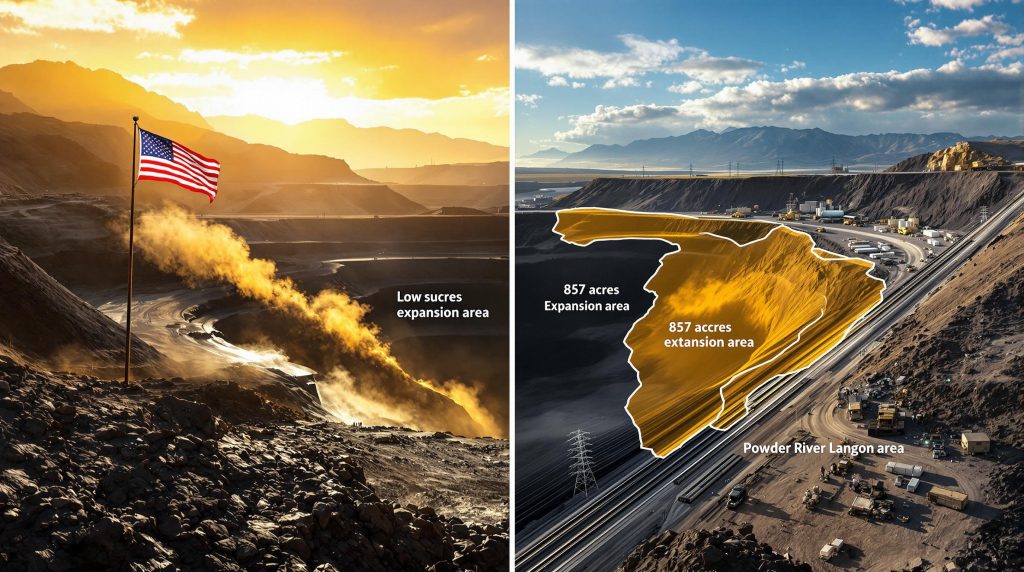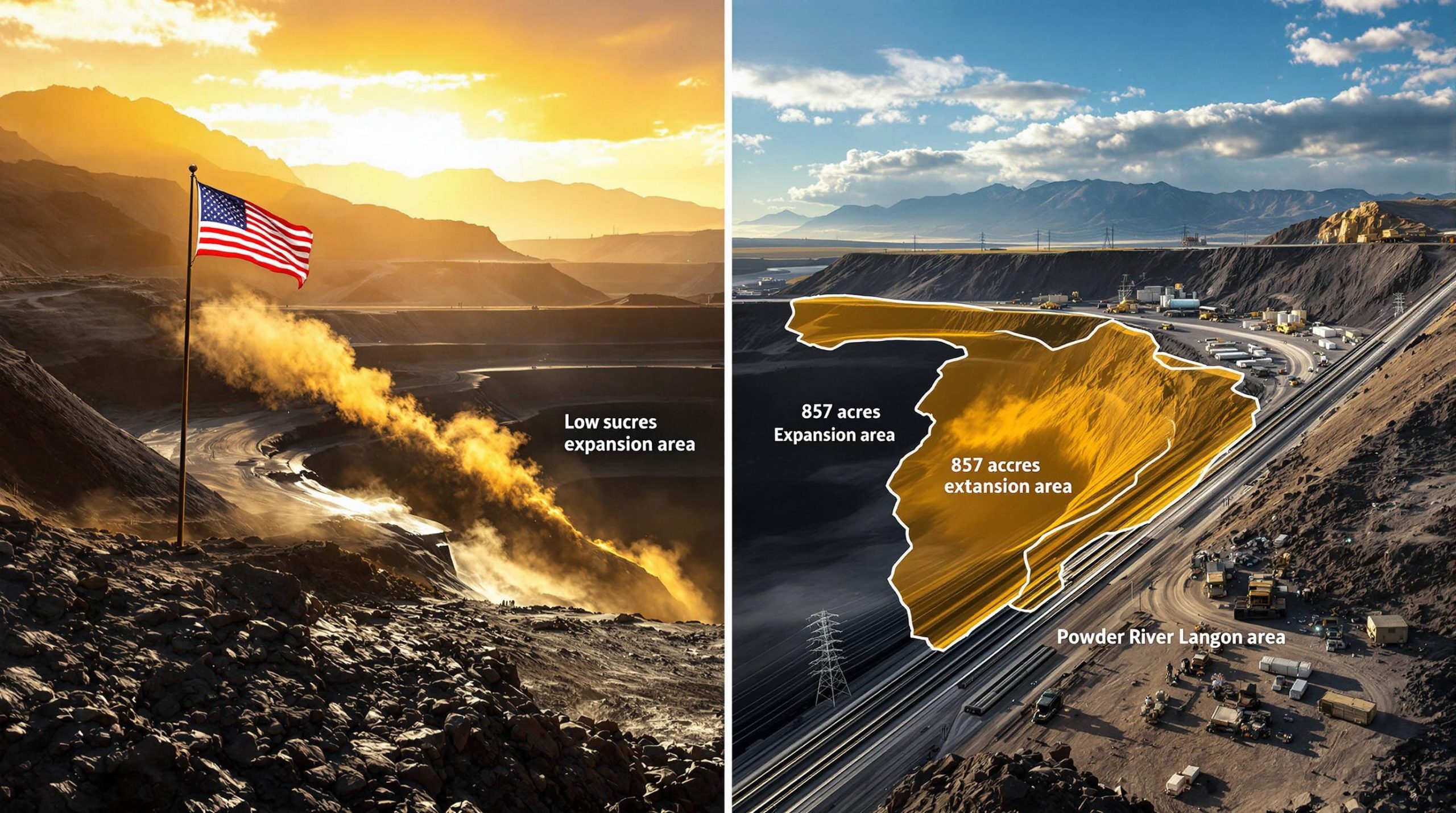Interior Approves Mining Plan to Unlock 14.5 Million Tonnes of Coal at Antelope Mine
The Department of Interior's recent approval of a mining plan modification for the Antelope Mine represents a significant development for Wyoming's coal industry. This decision unlocks access to 14.5 million tonnes of federally owned coal reserves in Converse County, extending the mine's operational lifespan until 2037 and securing hundreds of local jobs in a region where coal remains an economic cornerstone.
Understanding the Antelope Mine Expansion
The approved modification specifically addresses the West Antelope II South Tract, identified under Federal Coal Lease WYW-177903. This authorization covers approximately 857 acres of federal land, providing crucial support for continued mining operations. Navajo Transitional Energy Company, the mine's operator, will maintain operations that currently support 359 full-time employees across both Converse and Campbell counties.
"The administration is delivering on its promise to revitalize American coal and unleash our nation's energy potential," stated Secretary of the Interior Doug Burgum. "This decision boosts American jobs, enhances energy security strategy, and supports communities that rely on coal to power their homes and economies."
The expansion will utilize conventional surface-mining techniques to extract low-sulfur, low-ash, subbituminous coal – characteristics that make Powder River Basin coal particularly valuable for power generation. The mine's on-site rail facility enables direct shipment to customers throughout the country, maintaining an efficient supply chain for coal-fired power plants.
How Does This Decision Impact Wyoming's Coal Industry?
The Antelope Mine expansion represents a significant policy shift aimed at breathing new life into America's coal sector, particularly in Wyoming's critical Powder River Basin region. This approval comes at a time when many coal communities have faced uncertainty and economic challenges due to ongoing coal market transformation.
Economic and Employment Benefits
The preservation of 359 full-time positions directly tied to the mine's operations delivers immediate economic security to hundreds of families in Converse and Campbell counties. These jobs typically offer above-average wages and benefits compared to other local employment options, creating a multiplier effect throughout the regional economy.
Beyond direct employment, the extension of mining operations until 2037 provides long-term stability for local businesses, contractors, and service providers that support the mine's activities. From equipment suppliers to transportation services, numerous secondary businesses benefit from the mine's continued operation.
Acting Assistant Secretary for Land and Mineral Management Adam Suess emphasized this broader context: "As global instability continues to threaten energy markets, the need for reliable, domestic coal has never been clearer. This action underscores our commitment to common-sense mining permitting insights, environmental stewardship and energy dominance."
Supply Chain Significance
The Antelope Mine serves as a critical link in America's energy supply chain. The low-sulfur coal produced at this operation is delivered to power plants and industrial customers across the country, helping to maintain stable electricity prices and reliable power generation in multiple states.
The mine's strategic location within the Powder River Basin and its well-developed rail infrastructure allow for efficient transportation of coal to markets throughout the Midwest and beyond. This logistical advantage helps maintain the competitiveness of American coal against other energy sources and imported coal products.
What Environmental Assessments Were Conducted?
Before granting approval for the mining plan modification, the Office of Surface Mining Reclamation and Enforcement (OSMRE) completed a comprehensive environmental review process in accordance with federal regulations.
Environmental Review Framework
The assessment was conducted under the National Environmental Policy Act (NEPA), which requires federal agencies to evaluate the environmental impacts of their actions before making decisions. This process involved analyzing potential effects on air quality, water resources, wildlife, cultural resources, and local communities.
Following this thorough review, OSMRE issued a Finding of No Significant Impact (FONSI), determining that the proposed expansion would not result in significant adverse environmental effects. This conclusion suggests that existing mitigation measures and operational practices are sufficient to address potential environmental concerns.
Ongoing Regulatory Oversight
The approval includes provisions for continued monitoring and regulatory oversight throughout the mine's extended operational period. These measures ensure compliance with science-based federal guidelines for coal mining activities, including reclamation requirements that will eventually return the land to productive use after mining operations conclude.
Environmental management at the site must address numerous factors, including:
- Water quality protection for surface and groundwater resources
- Dust control and air quality monitoring
- Wildlife habitat considerations
- Land reclamation planning and implementation
- Cultural resource protection
This regulatory framework aims to balance resource development with environmental protection, ensuring that coal extraction proceeds responsibly while minimizing negative impacts.
How Does This Decision Align With Current Energy Policy?
The mining plan modification approval reflects a broader energy strategy focused on domestic production and energy independence. This approach prioritizes American resources as a foundation for economic security and grid reliability.
Policy Framework and Executive Actions
The Antelope Mine expansion aligns with executive orders designed to boost the clean coal industry and promote energy independence. These policy initiatives aim to reduce regulatory barriers while maintaining appropriate environmental safeguards.
A key legislative component supporting this direction is the One Big Beautiful Bill Act, which helps the coal industry by lowering royalty payments for mining coal on federal land and making more land available for coal mining. This act represents a significant policy shift intended to revitalize coal-producing regions.
The approval also demonstrates a commitment to streamlining permitting processes for energy projects without compromising environmental standards. This balanced approach seeks to eliminate unnecessary delays while ensuring thorough review of potential impacts.
Energy Security Considerations
Domestic coal production plays an important role in the administration's energy security strategy. As global energy markets face increasing volatility due to geopolitical tensions, natural disasters, and supply chain disruptions, maintaining diverse energy sources becomes increasingly important.
The Antelope Mine's continued operation contributes to this diversification by ensuring that coal remains available as a reliable baseload power generation option. This helps protect against price spikes and supply disruptions that can occur with over-reliance on any single energy source or imported fuels.
Additionally, maintaining coal as part of the energy mix provides fuel diversity for electric utilities, allowing them to optimize their generation portfolios based on changing market conditions and fuel prices.
What Other Recent Coal Mining Approvals Have Occurred?
The Antelope Mine decision follows other recent approvals that demonstrate the administration's commitment to coal industry revitalization. These actions collectively represent a significant policy shift in federal resource management.
Hurricane Creek Mining Authorization
Among the notable recent approvals is the authorization for Hurricane Creek Mining, LLC to conduct coal mining operations on Bryson Mountain in Claiborne County, Tennessee. This project is expected to produce up to 1.8 million tonnes of coal over a 10-year period, creating jobs and economic activity in an area that has historically relied on coal mining.
The Hurricane Creek approval followed a similar environmental review process, with agencies determining that with proper mitigation measures, the mining operation could proceed without significant environmental harm.
Broader Coal Revitalization Efforts
These individual project approvals form part of a coordinated effort to restore American energy leadership through coal production. The approach emphasizes:
- Expedited permitting while maintaining environmental standards
- Reduced regulatory compliance costs
- Enhanced access to federal coal resources
- Support for coal mining communities
- Investment in clean coal technologies
These initiatives aim to reverse previous declines in coal production and employment, particularly in regions where few alternative industries exist to support local economies.
What Is the Significance of the Powder River Basin?
The Powder River Basin represents one of America's most important coal-producing regions, spanning portions of Wyoming and Montana. The Antelope Mine serves as a key contributor to national energy production within this geologically significant area.
Geological and Production Advantages
The Basin is known for its relatively thick, continuous coal seams that can be efficiently extracted through surface mining methods. These geological characteristics contribute to lower production costs compared to underground mining operations in other regions.
The coal deposits in the Powder River Basin formed millions of years ago from ancient peat bogs and wetlands. Over time, these organic materials were compressed and transformed into the subbituminous coal that is now extracted. The region's coal typically contains:
- Lower sulfur content (0.2-0.9%) compared to Eastern U.S. coal
- Moderate heat content (8,000-9,500 BTU/lb)
- Lower ash content
- Reduced levels of certain harmful elements
These characteristics make Powder River Basin coal particularly valuable for power plants seeking to meet emissions standards while maintaining efficient electricity generation.
Infrastructure and Transportation Networks
The Powder River Basin benefits from well-developed rail infrastructure that efficiently connects mines to power plants across the country. Major rail lines operated by Burlington Northern Santa Fe (BNSF) and Union Pacific Railroad transport coal from the region to customers throughout the Midwest and beyond.
The Antelope Mine's on-site rail loading facilities allow for direct shipment, reducing handling costs and improving operational efficiency. This transportation network represents a significant investment that supports not only coal shipments but also the movement of other goods throughout the region.
Regional Economic Importance
Coal mining in the Powder River Basin serves as an economic foundation for numerous communities in Wyoming and Montana. The industry provides high-paying jobs, tax revenue for local governments, and support for community services ranging from schools to healthcare facilities.
The continued operation of mines like Antelope helps maintain this economic base while allowing communities time to develop diversification strategies for long-term economic sustainability. Furthermore, these operations contribute significantly to North American mining trends that shape the continental energy landscape.
FAQ: Antelope Mine Expansion Project
What federal agency approved the mining plan modification?
The Office of Surface Mining Reclamation and Enforcement (OSMRE), operating under the Department of the Interior, issued the approval following a comprehensive environmental assessment process. This agency is responsible for balancing mineral development with environmental protection on federal lands.
How many jobs does the Antelope Mine currently support?
The mine employs 359 full-time workers across operations in Converse and Campbell counties. These positions include equipment operators, maintenance personnel, engineers, environmental specialists, and administrative staff.
What type of coal is produced at the Antelope Mine?
The mine produces low-sulfur, low-ash, subbituminous coal, which is valued for its relatively cleaner burning properties compared to other coal types. This coal quality makes it particularly suitable for power plants equipped with modern emissions control technologies.
How long will the newly approved coal reserves last?
The approval extends the operational life of the Antelope Mine until 2037, adding approximately 12 years to its productive lifespan. This timeframe is based on projected mining rates and the quantity of recoverable coal within the approved area.
What environmental review process was completed before approval?
A full environmental assessment was conducted under the National Environmental Policy Act, resulting in a Finding of No Significant Impact determination. This process evaluated potential effects on various environmental factors including water quality, air quality, wildlife habitat, and cultural resources.
How does the coal reach customers once mined?
The Antelope Mine features an on-site rail loading facility that connects directly to major rail networks. This infrastructure allows coal to be loaded efficiently onto trains for delivery to power plants and industrial customers throughout the United States.
Coal Mining Techniques at Antelope Mine
Surface Mining Methods
The Antelope Mine utilizes traditional surface mining techniques, commonly known as open-pit or strip mining. This approach is well-suited to the relatively flat terrain and shallow coal seams of the Powder River Basin.
The mining process typically follows these steps:
- Topsoil removal and storage for later reclamation use
- Overburden removal using large draglines, shovels, and trucks
- Coal extraction using specialized equipment like loaders and haul trucks
- Reclamation activities including regrading, topsoil replacement, and revegetation
This systematic approach allows for efficient resource recovery while preparing for eventual land restoration once mining concludes in each section. The mine's commitment to mine reclamation innovations ensures that the land can be returned to productive use after operations cease.
Reclamation Commitments
Federal regulations require comprehensive reclamation of mined lands, and the Antelope Mine must adhere to these standards as part of its operational approval. Reclamation activities include:
- Restoring approximate original contours of the land
- Replacing topsoil and establishing native vegetation
- Creating wildlife habitat features
- Ensuring hydrological system restoration
- Monitoring reclaimed areas for successful revegetation
These efforts aim to return the land to productive use after mining operations conclude, often creating rangeland suitable for livestock grazing and wildlife habitat.
Disclaimer: This article contains information about mining operations, regulatory approvals, and potential economic impacts based on current understanding. Future developments in energy markets, regulatory environments, and technological advancements could affect the projections and timelines discussed. Readers should consult official sources for the most current information when making decisions related to energy investments or policy considerations.
Looking for Investment Opportunities in the Mining Sector?
Discover potential market-moving developments in the mining and resources sector with Discovery Alert's proprietary Discovery IQ model, which provides real-time notifications of significant ASX mineral discoveries. Visit the Discovery Alert discoveries page to see how major mineral finds can generate substantial returns for well-positioned investors.




